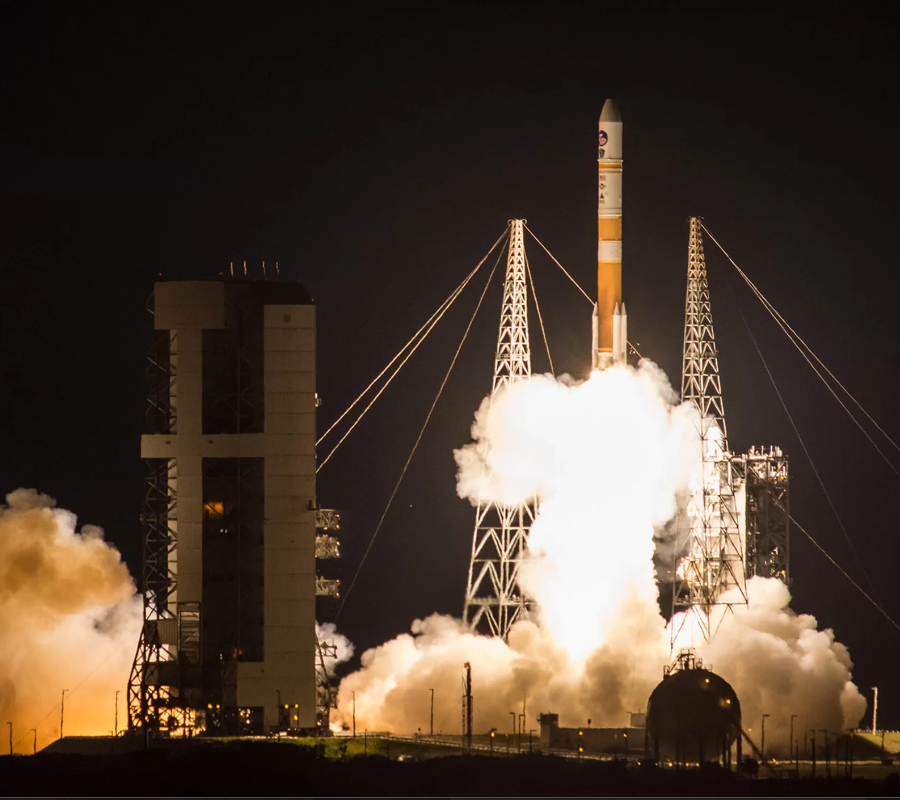The United Launch Alliance directed the launch of a Delta IV rocket carrying the $445 million military communications satellite WGS-9 at 00:18 GMT this Sunday.
The rocket lifted off from Cape Canaveral Air Force Station at 8:18 p.m. local time, a tad later than it was initially scheduled due to technical issues concerning ground support. WSG-9 is the U.S. Air Force’s latest Wideband Global SATCOM manufactured by Boeing. It will serve to broadcast conferences, images, and other sorts of data among military units and command posts, the White House, and the Department of State.

Defending ground, sea, air, and space
According to Bob Tarleton, director of Space and Missile Systems Center’s Military Satellite Communications Systems Directorate, launching the WSG-9 marks a 20-year milestone after years of cooperation with Canada, Denmark, Luxembourg, the Netherlands, and New Zealand.
Boeing signed a contract with the United Launch Alliance to make the WSG system a reality, consisting of two satellites and an optional third. Previously known as the Wideband Gapfiller Satellite, the WSG constellation was envisioned to replace older satellites as they were nearing their expiration date. A single new model would provide at least ten times the transmission speed of the sum of all the DSCS satellites that remained in orbit.

The WSG-9, alongside other satellites, were ordered in 2010. These new models are based on the BSS-702 platform envisioned by Boeing. They are designed to last at least 14 years in orbit and will support 8.88 GHz of bandwidth, with a downlink top speed of 11 gigabits per second.
Since 2009, all launches have been made on Delta IV rockets, also developed by Boeing, but based on the Air Force’s Evolved Expendable Launch Vehicle program.
Only a single WSG satellite remains from being launched, the WSG-10. It is staged for launch in 2019 on the last Delta IV launch to use just one Common Booster Core on its first stage.
Military strategists agree that the next great wars could be based on space affairs. Russia has already deployed the “Kosmos 2499,” designed to seek and destroy American satellites. China is also attentive of the matter, as it launched the “Shiyan,” which can use a robotic arm to get enemy satellites out of orbit.
Reportedly, the U.S. is not entirely prepared for space warfare, although it can respond if it were attacked in space. A common analogy is the usage of depth charges deployed by the Navy during World War II, which served to counter enemy submarines without necessarily using submarines on their own.
“As humans go out there, there has always been conflict. Conflict in the Wild West as we move in the West… conflict twice in Europe for its horrible world wars. So, every time humans actually physically move into that, there’s conflict, and in that case, we’ll have to be prepared for that,” stated General John Hyten, chief of U.S. Strategic Command, to CNN.
Laser-based warfare
The U.S. Navy is preparing its Laser Weapons System (LaWS), which is deployed in the Persian Gulf, aboard the USS Ponce. Back in 2014, the Navy tested a 30-kW laser weapon, able to take out small drones. Later, in 2016, they prepared to test a 150-kW laser, which is more than what regular warships can accommodate in their operative structure.
Laser systems are still in their early stages and suffer from some limitations. For example, bad weather can make them inoperable, and they are not nearly as powerful as a missile. On the other hand, lasers are incredibly cheaper to operate, as they are based solely on power, and their ammo does not have to be stored just like a missile would. Apparently, each shot would cost one gallon of diesel fuel.
The 150-kW laser, which would be fired by a DDG-1000 emitter will use some “energy magazine,” which would store energy for the laser and could be recharged between firing sessions. The latest energy magazine of the kind is developed by DRS Power and Control Technologies, and it can sustain over 100 shots before needing to recharge.
A demonstration of the magazine is scheduled for 2018, with the 150-kW laser, although the system must undergo strenuous certification from the Navy.
One of the benefits of using lasers is that they do not necessarily need to destroy the target, as it is usually sufficient to render it inoperable. For ground troops, it may be useful to cause a car to stop running, which would be possible thanks to the laser’s pinpoint accuracy, reducing the need for worrying about collateral damages.
A powerful enough laser might be just what the U.S. needs to fend off enemy satellites, as they are delicate pieces of equipment that do not move too fast and can be easily pinpointed by a beam.
Source: Space Ref
